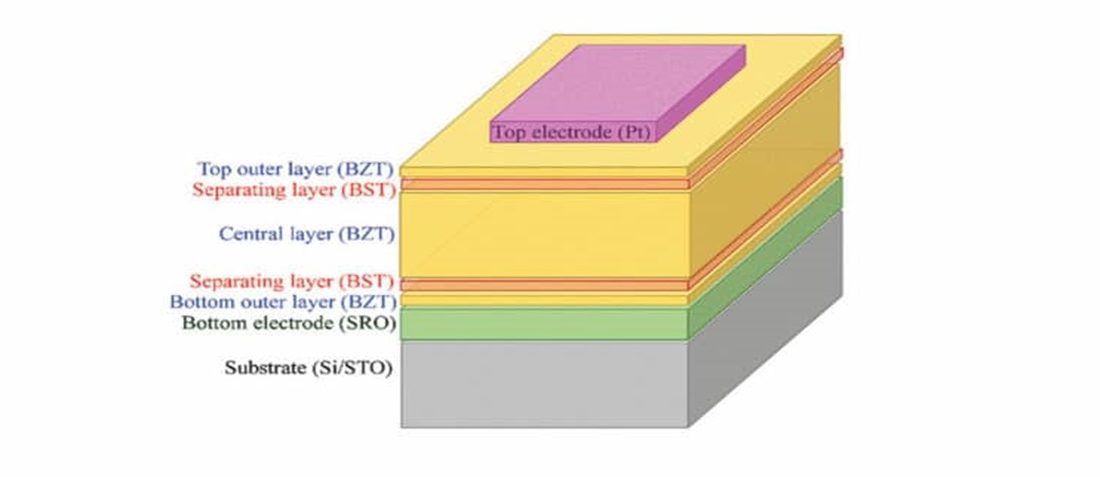
Researchers Demonstrated High Energy Storage, High Strength Multilayer Ferroelectric Dielectric Material
- Posted by doEEEt Media Group
- On July 31, 2024
- 0
Researchers at the University of Twente proposed multilayer dielectric material that shows excellent energy storage properties and outperforms any lead-free thin film multilayer ferroelectric high energy storage capacitor. The study was published in the journal Advanced Materials.
Researcher Minh Duc Nguyen and his colleagues worked on a new capacitor design strategy based on BST/BZT ceramic dielectric materials to improve their energy storage, decrease the amount of energy lost every time it is charged or discharged, and increase the number of times they can reliably charge and discharge.
Pacemakers, defibrillators, radar technology, and electric vehicles all need capacitors that can store and release a lot of energy in a matter of a few microseconds.
Nguyen and his team work on a type of capacitor that uses multiple thin layers of different materials. By adding layers they were able to increase the efficiency to over 90%. This means it loses less than 10% of the electric charge used for charging. That is two times less energy loss compared to the usual designs. It functions in a wide temperature range of 25–200 °C and can charge and discharge up to 10 billion times. Enough to do it once every second for over 300 years.
The researchers deduced design optimisation rules for the combination of materials they used. “These rules are also expected to be useful for optimizing other multilayer systems and are therefore very relevant for further increasing the energy storage density of capacitors”, they write in their publication. This paves the way for even better capacitors.
More information: –Minh D. Nguyen et al, Toward Design Rules for Multilayer Ferroelectric Energy Storage Capacitors – A Study Based on Lead‐Free and Relaxor‐Ferroelectric/Paraelectric Multilayer Devices, Advanced Materials (2024). DOI: 10.1002/adma.202402070
Abstract
Future pulsed-power electronic systems based on dielectric capacitors require the use of environment-friendly materials with high energy-storage performance that can operate efficiently and reliably in harsh environments. Here, a study of multilayer structures, combining paraelectric-like Ba0.6Sr0.4TiO3 (BST) with relaxor-ferroelectric BaZr0.4Ti0.6O3 (BZT) layers on SrTiO3-buffered Si substrates, with the goal to optimize the high energy-storage performance is presented.
The energy-storage properties of various stackings are investigated and an extremely large maximum recoverable energy storage density of ≈165.6 J cm−3 (energy efficiency ≈ 93%) is achieved for unipolar charging-discharging of a 25-nm-BZT/20-nm-BST/910-nm-BZT/20-nm-BST/25-nm-BZT multilayer structure, due to the extremely large breakdown field of 7.5 MV cm−1 and the lack of polarization saturation at high fields in this device. Strong indications are found that the breakdown field of the devices is determined by the outer layers of the multilayer stack and can be increased by improving the quality of these layers. Authors are also able to deduce design optimization rules for this material combination, which can be, to a large extent, justified by structural analysis. These rules are also expected to be useful for optimizing other multilayer systems and are, therefore, very relevant for further increasing the energy storage density of capacitors.
Source: University of Twente in EPCI Blog
- Space-Grade components available for immediate delivery - April 10, 2025
- Exclusive stock on doEEEt: How to access and request - April 10, 2025
- Managing EEE components for LEO and lower cost space missions - December 17, 2024

0 comments on Researchers Demonstrated High Energy Storage, High Strength Multilayer Ferroelectric Dielectric Material